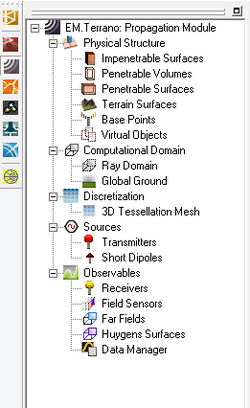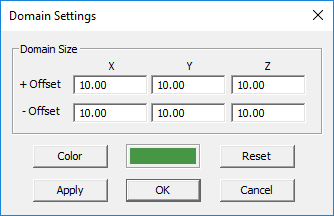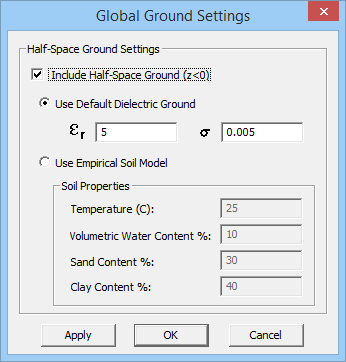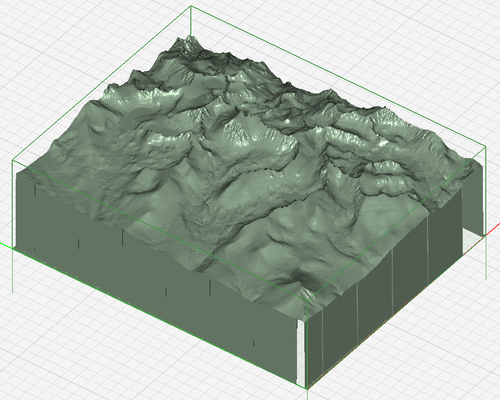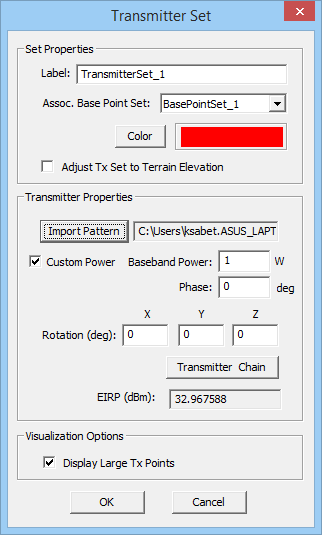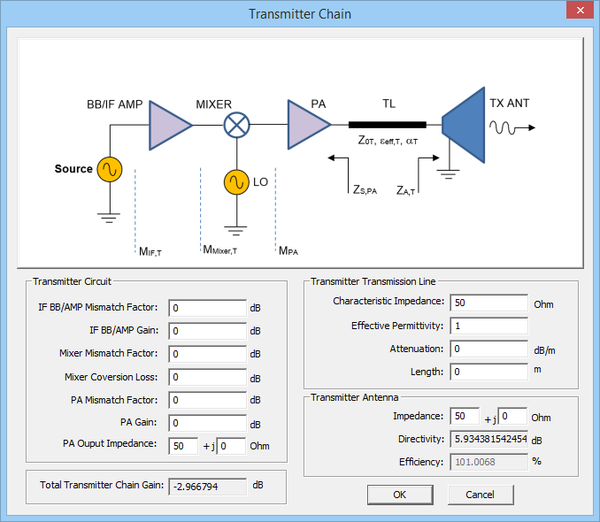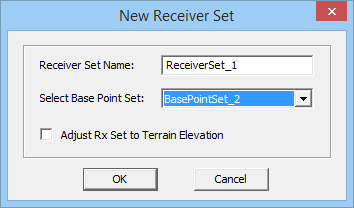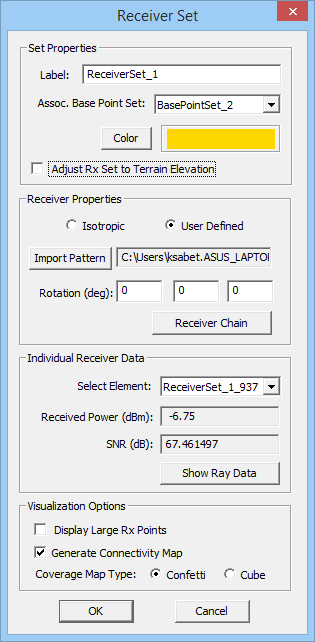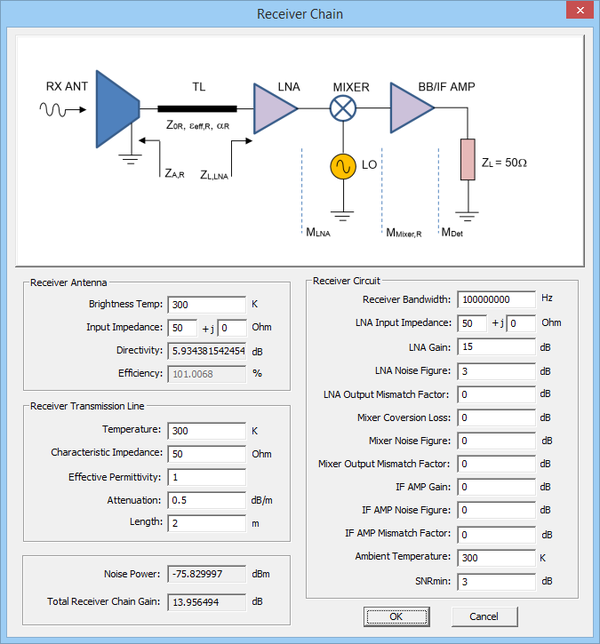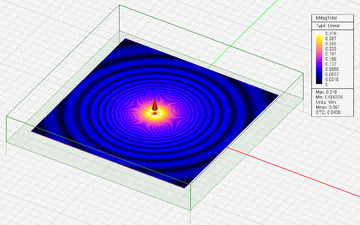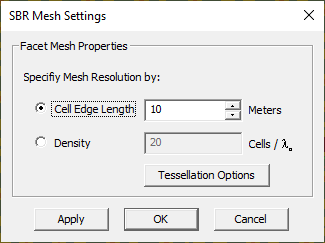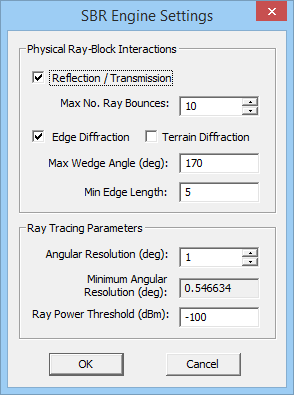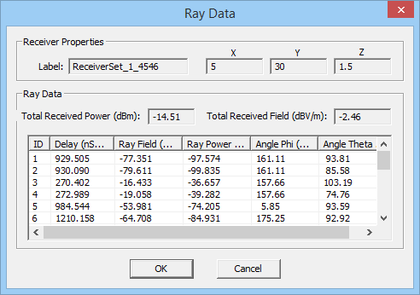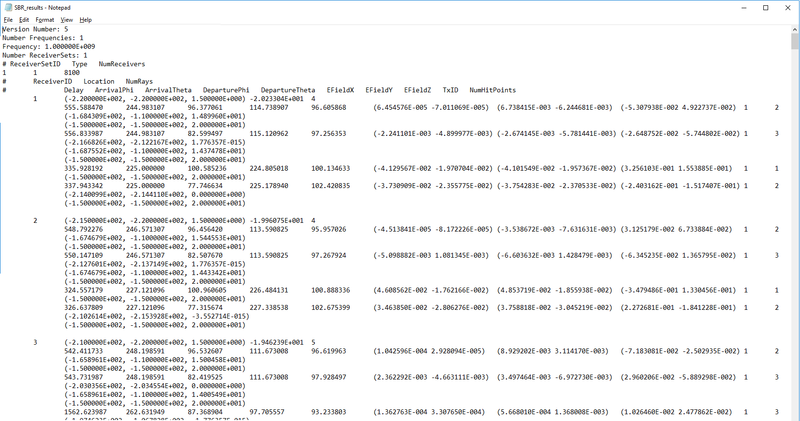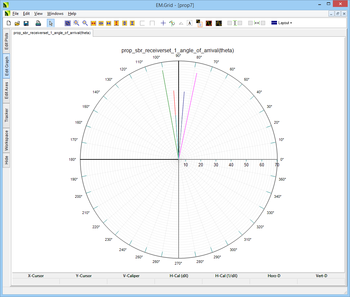Difference between revisions of "EM.Terrano"
Kazem Sabet (Talk | contribs) (→Buildings, Terrain & Obstructing Blocks) |
Kazem Sabet (Talk | contribs) (→Buildings, Terrain & Obstructing Blocks) |
||
| Line 100: | Line 100: | ||
! scope="col"|Legitimate Object Types | ! scope="col"|Legitimate Object Types | ||
|- | |- | ||
| − | | Impenetrable Surface | + | | [[Block_Types#Impenetrable_Surfaces_for_Outdoor_Scenes | Impenetrable Surface]] |
| Reflection, Diffraction | | Reflection, Diffraction | ||
| All solid & surface CAD objects | | All solid & surface CAD objects | ||
Revision as of 02:01, 13 August 2015
Contents
- 1 An EM.Terrano Primer
- 2 Building a Propagation Scene
- 3 Defining Sources & Observables for Your SBR Simulation
- 4 Defining Transmitters & Receivers for Your Propagation Scene
- 5 Using EM.Terrano as an Asymptotic Field Solver
- 6 Discretizing the Propagation Scene
- 7 Running an SBR Simulation
- 8 Working with SBR Simulation Data
An EM.Terrano Primer
EM.Terrano in a Nutshell
EM.Terrano is a physics-based, site-specific, wave propagation modeling tool that enables engineers to quickly determine how radio waves propagate in urban, natural or mixed environments. EM.Terrano's simulation engine is equipped with a fully polarimetric, coherent ray tracing solver based on the Shooting-and-Bouncing-Rays (SBR) method, which utilizes geometrical optics (GO) in combination with uniform theory of diffraction (UTD) models of building edges. EM.Terrano lets you analyze and resolve all the rays transmitted from one ore more signal sources, which propagate in a real physical site made up of buildings, terrain and other obstructing structures. EM.Terrano finds all the rays received by a receiver at a particular location in the physical site and computes their power levels, time delays, angles of arrival, etc. Using EM.Terrano you can examine connectivity of a communication link between any two points in a real specific propagation site.
| |
EM.Terrano is the ray tracing Propagation Module of EM.Cube, a comprehensive, integrated, modular electromagnetic modeling environment. EM.Teranno shares the visual interface, 3D parametric CAD modeler, data visualization tools, and many more utilities and features collectively known as CubeCAD with all of EM.Cube's other computational modules. |
![]() Click here to learn more about EM.Cube Modeling Environment.
Click here to learn more about EM.Cube Modeling Environment.
![]() Click here to learn more about the basic functionality of CubeCAD.
Click here to learn more about the basic functionality of CubeCAD.
Physics-Based Propagation Channel Modeling Using SBR Ray Tracing
Every wireless communication system involves a transmitter that transmits some sort of signal (voice, video, data, etc.), a receiver that receives and detects the transmitted signal, and a channel in which the signal is transmitted into the air and travels from the location of the transmitter to the location of the receiver. The channel is the physical medium in which the electromagnetic waves propagate. The successful design of a communication system depends on an accurate link budget analysis that determines whether the receiver receives adequate signal power to detect it against the background noise. The simplest channel is the free space. In a free-space line-of-sight (LOS) communication system, the signal propagates directly from the transmitter to the receiver without encountering any obstacles (scatterers). Free-space line-of-sight channels are ideal scenarios that can typically be used to model aerial or space communication system applications.
![]() Click here to learn more about the theory of a Free-Space Propagation Channel.
Click here to learn more about the theory of a Free-Space Propagation Channel.
Real communication channels, however, are more complicated and involve a large number of wave scatterers. For example, in an urban environment, the obstructing buildings, vehicles and vegetation reflect, diffract or attenuate the propagating radio waves. As a result, the receiver receives a distorted signal that contains several components with different power levels and different time delays arriving from different angles. The different rays arriving at a receiver location create constructive and destructive interference patterns. This is known as the multipath effect. This together with the shadowing effects caused by building obstructions lead to channel fading. The use of statistical models for prediction of fading effects is widely popular among communication system designers. These models are either based on measurement data or derived from simplistic analytical frameworks. The statistical models often exhibit considerable errors especially in areas having mixed building sizes. In such cases, one needs to perform a physics-based, site-specific analysis of the propagation environment to accurately identify and establish all the possible signal paths from the transmitter to the receiver. This involves an electromagnetic analysis of the scene with all of its geometrical and physical details.
Link budget analysis for a multipath channel is a challenging task due to the large size of the computational domains involved. Typical propagation scenes usually involve length scales on the order of thousands of wavelengths. To calculate the path loss between the transmitter and receiver, one must solve Maxwell's equations in an extremely large space. Full-wave numerical techniques like the Finite Difference Time Domain (FDTD) method, which require a fine discretization of the computational domain, are therefore impractical for solving large-scale propagation problems. The practical solution is to use asymptotic techniques such as SBR, which utilize analytical techniques over large distances rather than a brute force discretization of the entire computational domain. Such asymptotic techniques, of course, have to compromise modeling accuracy for computational efficiency.
EM.Terrano provides an asymptotic ray tracing simulation engine that is based on a technique known as Shooting-and-Bouncing-Rays (SBR). In this technique, propagating spherical waves are modeled as ray tubes or beams that emanate from a source, travel in space, bounce from obstacles and are collected by the receiver. As rays propagate away from their source (transmitter), they begin to spread (or diverge) over distance. In other words, the cross section or footprint of a ray tube expands as a function of the distance from the source. EM.Terrano uses an accurate equi-angular ray generation scheme to that produces almost identical ray tubes in all directions to satisfy energy and power conservation requirements.
When a ray hits an obstructing surface, one or more of the following phenomena may happen:
- Reflection from the locally flat surface
- Transmission through the locally flat surface
- Diffraction from an edge between two conjoined locally flat surfaces
![]() Click here to learn more about the Theory of SBR Method.
Click here to learn more about the Theory of SBR Method.
Advantages & Limitations of EM.Terrano's SBR Solver
EM.Terrano's SBR simulation engine utilizes an intelligent ray tracing algorithm that is based on the concept of k-dimensional trees. A k-d tree is a space-partitioning data structure for organizing points in a k-dimensional space. k-d trees are particularly useful for searches that involve multidimensional search keys such as range searches and nearest neighbor searches. In a typical large radio propagation scene, there might be a large number of rays emanating from the transmitter that may never hit any obstacles. For example, upward-looking rays in an urban propagation scene quickly exit the computational domain. Rays that hit obstacles on their path, on the other hand, generate new reflected and transmitted rays. The k-d tree algorithm traces all these rays systematically in a very fast and efficient manner. Another major advantage of k-d trees is the fast processing of multi-transmitters scenes.
EM.Terrano performs fully polarimetric and coherent SBR simulations with arbitrary transmitter antenna patterns. Its SBR simulation engine is a true asymptotic "field" solver. The amplitudes and phases of all the three vectorial field components are computed, analyzed and preserved throughout the entire ray tracing process from the source location to the field observation points. You can visualize the magnitude and phase of all six electric and magnetic field components at any point in the computational domain. In most scenes, the buildings and the ground or terrain can be assumed to be made of homogeneous materials. These are represented by their electrical properties such as permittivity εr and electric conductivity σ. More complex scenes may involve a multilayer ground or multilayer building walls. In such cases, one can no longer use the simple reflection or transmission coefficient formulas for homogeneous medium interfaces. EM.Terrano calculates the reflection and transmission coefficients of multilayer structures as functions of incident angle, frequency and polarization and uses them at the respective specular points.
It is very important to keep in mind that SBR is an asymptotic electromagnetic analysis technique that is based on Geometrical Optics (GO) and the Uniform Theory of Diffraction (UTD). It is not a "full-wave" technique, and it does not provide a direct numerical solution of Maxwell's equations. SBR makes a number of assumptions, chief among them, a very high operational frequency such that the length scales involved are much larger than the operating wavelength. Under this assumed regime, electromagnetic waves start to behave like optical rays. Virtually all the calculations in SBR are based on far field approximations. In order to maintain a high computational speed for urban propagation problems, EM.Terrano ignores double diffractions. Diffractions from edges give rise to a large number of new secondary rays. The power of diffracted rays drops much faster than reflected rays. In other words, an edge-diffracted ray does not diffract again from another edge in EM.Terrano. However, reflected and penetrated rays do get diffracted from edges just as rays emanated directly from the sources do.
Building a Propagation Scene
The Various Elements of a Propagation Scene
A typical propagation scene in EM.Terrano consists of several elements. At a minimum, you need a transmitter (Tx) at some location to launch rays into the scene and a receiver (Rx) at another location to receive and collect the incoming rays. A transmitter and a receiver together make the simplest propagation scene, representing a free-space line-of-sight (LOS) channel. A transmitter is one of EM.Terrano's several source types, while a receiver is one of EM.Terrano's several observable types. A simpler source type is a Hertzian dipole representing an almost omni-directional radiator. A simpler observable is a field sensor that is used to compute the electric and magnetic fields on a specified plane.
An outdoor propagation scene may involve several buildings modeled by impenetrable surfaces and an underlying flat ground or irregular terrain surface. An indoor propagation scene may involve several walls modeled by thin penetrable surfaces, a ceiling and a floor arranged according to a certain building layout. You can also build mixed scenes involving both impenetrable and penetrable blocks. Your sources and observables can be placed anywhere in the scene. Your transmitters and receivers can be placed outdoors or indoors. A complete list of the various elements of a propagation scene is given in the Physical Structure section of EM.Terrano's Navigation Tree as follows (click on each type to learn more about it):
- Impenetrable Surfaces: feature reflection and diffraction of impinging rays. Rays hit the facets of this type of blocks and bounce back, but they do not penetrate the object. It is assumed that the interior of such blocks or buildings are highly absorptive.
- Penetrable Surfaces: feature reflection, transmission and diffraction of impinging rays. These blocks represent thin surfaces that are used to model the exterior and interior walls of buildings. Rays reflect off the surface of penetrable surfaces and diffract off their edges. They also penetrate the thin surface and continue their path in the free space on the other side of the wall.
- Terrain Surfaces: feature reflection and optional diffraction of impinging rays. These blocks are used to provide one or more impenetrable, ground surfaces for the propagation scene. Rays simply bounce off terrain objects.
- Penetrable Volumes: feature reflection, transmission and diffraction of impinging rays. These blocks are used to model propagation inside general material media or special environments such as fog, rain and vegetation.
- Base Points: are used to locate a single transmitter or receiver or arrays of transmitters or receivers in the scene.
![]() Click here to learn more about Block Types.
Click here to learn more about Block Types.
In EM.Terrano, the various scene elements like buildings, terrain objects and base points are grouped together based on their type. All the objects listed under a particular group in the navigation tree share the same color, texture and material properties. Once a new block group has been created in the navigation tree, it becomes the "Active" group of the project workspace, which is always displayed in bold letters. You can start drawing new objects under the active node. Any block group can be made active by right-clicking on its name in the navigation tree and selecting the Activate item of the contextual menu.
It is recommended that you first create block groups, and then draw new objects under the active block group. However, if you start a new EM.Terrano project from scratch, and start drawing a new object without having previously defined any block groups, a new default impenetrable surface group is created and added to the navigation tree to hold your new CAD object. You can always change the properties of a block group later by accessing its property dialog from the contextual menu. You can also delete a block group with its objects at any time.
Why Do You Need a Finite Computational Domain?
The SBR simulation engine requires a finite computational domain for ray termination. All the stray rays that emanate from a source inside this finite domain and hit its boundaries are terminated during the simulation process. Such rays exit the computational domain and travel to the infinity, with no chance of ever reaching any receiver in the scene. When you define a propagation scene with various elements like buildings, walls, terrain, etc., a dynamic domain is automatically established and displayed as a green wireframe box that surrounds the entire scene. Every time you create a new object, the domain box is automatically adjusted and extended to enclose all the objects in the scene.
To change the ray domain settings, follow the procedure below:
- Open the Ray Domain Settings Dialog by clicking the Domain
 button of the Simulate Toolbar, or by selecting Menu > Simulate > Computational Domain > Settings..., or by right-clicking on the Ray Domain item of the navigation tree and selecting Domain Settings... from the contextual menu, or simply using the keyboard shortcut Ctrl+A.
button of the Simulate Toolbar, or by selecting Menu > Simulate > Computational Domain > Settings..., or by right-clicking on the Ray Domain item of the navigation tree and selecting Domain Settings... from the contextual menu, or simply using the keyboard shortcut Ctrl+A.
- The size of the Ray domain is specified in terms of six Offset parameters along the ±X, ±Y and ±Z directions. The default value of all these six offset parameters is 10 project units. Change these values as you like.
- You can also change the color of the domain box using the Color button.
- After changing the settings, use the Apply button to make the changes effective while the dialog is still open.
Understanding the Global Ground
Most outdoor and indoor propagation scenes include a flat ground at their bottom, which bounces incident rays back into the scene. EM.Terrano provides a global flat ground at z = 0. The global ground indeed acts as an impenetrable surface that blocks the entire computational domain from the z = 0 plane downward. It is displayed as a translucent green plane at z = 0 extending downward. The color of the ground plane is always the same as the color of the ray domain. The global ground is assumed to be made of a homogeneous dielectric material with a specified permittivity εr and electric conductivity σ. By default, a rocky ground is assumed with εr = 5 and σ = 0.005 S/m. You can remove the global ground, in which case, you will have a free space scene. To disable the global ground, open up the "Global Ground Settings" dialog, which can be accessed by right clicking on the Global Ground item in the Navigation Tree and selecting Global Ground Settings... Remove the check mark from the box labeled "Include Half-Space Ground (z<0)" to disable the global ground. This will also remove the green translucent plane from the bottom of your scene. You can also change the material properties of the global ground and set new values for the permittivity and electric conductivity of the impenetrable, half-space, dielectric medium.
Alternatively, you can use EM.Terrano's Empirical Soil Model to define the material properties of the global ground. This model requires a number of parameters: Temperature in °C, and Volumetric Water Content, Sand Content and Clay Content all as percentage.
| |
To model a free-space propagation scene, you have to disable EM.Terrano's default global ground. |
Buildings, Terrain & Obstructing Blocks
Impenetrable, penetrable and terrain surfaces and penetrable volumes represent buildings, blocks or objects that obstruct the propagation of electromagnetic waves (rays) in the free space. What differentiates them is the types of physical phenomena that are used to model their interaction with the impinging rays. The field intensity, phase and power of the reflected and transmitted rays depend on the material properties of the obstructing surface. The specular surface can be modeled as a simple homogeneous dielectric half-space or as a multilayer structure. In that respect, the buildings, walls, terrain or even the global ground all behave in a similar way:
- They terminate an impinging ray and replace it with one or more new rays.
- They represent a specular interface between two media of different material compositions for calculating the reflection, transmission and possibly diffraction coefficients.
EM.Terrano has generalized the concept of Block as any object that obstructs and affects radio wave propagation. The following table summarized the block types (click on each type to learn more about it):
| Block Type | Physical Effects | Legitimate Object Types |
|---|---|---|
| Impenetrable Surface | Reflection, Diffraction | All solid & surface CAD objects |
| Penetrable Volume | Reflection, Diffraction, Material Medium Transmission | All solid CAD objects |
| Penetrable Surface | Reflection, Diffraction, Thin-Wall Transmission | All solid & surface CAD objects |
| Terrain Surface | Reflection | Specially created tessellated objects only |
![]() Click here to learn more about all the different Block Types in EM.Terrano.
Click here to learn more about all the different Block Types in EM.Terrano.
![]() Click here to learn more about Moving Objects among Block Groups.
Click here to learn more about Moving Objects among Block Groups.
| |
Except for external terrain models, you can import other external objects (STEP, IGES, STL, etc.) only to CubeCAD. From CubeCAD, you can then move the imported objects to EM.Terrano. |
![]() Click here for a general discussion of Defining Materials in EM.Cube.
Click here for a general discussion of Defining Materials in EM.Cube.
Defining Base Point Sets

EM.Terrano uses Point objects to position transmitters and receiver in the propagation scene. Points are regular CAD objects that can be moved around (translated) in the project workspace. The point objects that are used to represent the transmitters and receivers are grouped together and organized as Base Sets in the "Physical Structure" section of the navigation tree. When you move the point objects or change their coordinates, all of their associated transmitters or receivers immediately follow them to the new location. For example, you can define a grid of receivers using a base set that is made up of a uniformly spaced array of points and spread them in your scene. You can easily interchange the role of transmitters and receivers in a scene by switching their associated bases. The usefulness of concept of base sets will become apparent later when we discuss placement of transmitters or receivers on an irregular terrain and adjustment of their elevation.
To create a new base set, follow these steps;
- Right-click on the Base Sets item of navigation tree and select Insert Base Set... A dialog for setting up the Base Set properties opens up.
- Enter a name for the base set and change the default blue color if you wish. It is useful to differentiate the base sets associated with transmitters and receivers by their color.
- Click the OK button to close the Base Set Dialog.
Once a base set node has been added to the navigation tree, it becomes the active node for drawing new objects. Under base sets, you can only draw point objects. All other object creation tools are disabled. A point is initially drawn on the XY plane. Make sure to change the Z-coordinate of your point, otherwise, your radiator will fall on the global ground at z = 0. You can also create arrays of base points under the same base set. This is particularly useful for setting up receiver grids to compute coverage maps. Simply select a point object and click the Array Tool of Tools Toolbar or use the keyboard shortcut "A". Enter values for the X, Y or Z spacing as well as the number of elements along these three directions in the Array Dialog. In most propagation scenes you are interested in 2D horizontal arrays along a fixed Z coordinate (parallel to the XY plane).
Defining Sources & Observables for Your SBR Simulation
Like every other electromagnetic solver, EM.Terrano's SBR ray tracer requires an excitation source and one or more observables for generation of simulation data. EM.Terrano offers several types of sources and observables for a SBR simulation. You can mix and match different source types and observable types depending on the requirements of your modeling problem. The available source types are (click on each type to learn more about it):
The available observables types are (click on each type to learn more about it):
A short dipole source is the simplest type of excitation for your propagation scene. A short dipole has an almost "omni-directional" radiation pattern, and is the closest thing to an isotropic radiator. EM.Terrano does not provide a theoretical/hypothetical isotropic transmitter because its SBR solver is fully polarimetric and requires a real physical radiator for ray generation. A transmitter is a more sophisticated source that requires a base point as well as an imported radiation pattern file with a .RAD file extension.
Of the above list of EM.Terrano's observables types, receivers are the ones you would typically use for your propagation scenes. Unlike a transmitter, a receiver by default does not require an imported radiation pattern file. A default receiver is assumed to be polarization-matched to the incoming ray. The other three observable types, field sensor, far fields and Huygens surface are primarily used in applications that utilize EM.Terrano as an asymptotic electromagnetic field solver. The Huygens surface observable is primarily used for hybrid modeling using multiple simulation engines.
| |
In order to define either transmitters or receivers, first you have to define base points. For a transmitter, you additionally need to import a radiation pattern file from one of EM.Cube's other computational modules. |
Defining Transmitters & Receivers for Your Propagation Scene
Defining Transmitter Sets
A transmitter is a point radiator with a fully defined polarimetric radiation pattern over the entire 3D space in the spherical coordinate system. You can model a radiating structure using EM.TEmpo, EM.Picasso, EM.Libera or EM.Illumina and generate a 3D radiation pattern data file for it. These data are stored in a specially formatted file with a ".RAD" file extension. It contains columns of spherical φ and θ angles as well as the real and imaginary parts of the complex-valued far field components Eθ and Eφ. The θ- and φ-components of the far-zone electric field determine the polarization of the transmitting radiator.
![]() Click here to learn more about the format of Radiation Pattern Files.
Click here to learn more about the format of Radiation Pattern Files.
To define a transmitter source in EM.Terrano, first you need to have at least one Base Point in your project workspace. Follow the procedure below:
- Right-click on the Transmitters item of the navigation tree and select Insert New Transmitter Set... from the contextual menu. This opens of the Transmitter Set dialog.
- Choose a name and color for your transmitter set.
- From the dropdown list labeled Associated Base Point Set, select the desired set.
- In the "Custom Pattern Parameters", click the Import Pattern button to set the path for the radiation data file. This opens up the standard Windows Open dialog, with the default file type or extension set to .RAD. Browse your folders to find the right data file.
- You can also rotate the imported pattern about the three principal axes. Enter the rotation angles other than the zero default values, if necessary.
- Click the OK button of the dialog to close it.
A new transmitter set entry is added in the Transmitters section of the navigation tree. After defining a transmitter set, the base points associated with it change their color to the transmitter color, which is red by default. In the Transmitter Set dialog, you can also set the Baseband Power of your transmitter in Watts and its Phase in degrees. There is a check box labeled Custom Power, which is checked by default. In that case, the power and phase boxes are enabled and you can change the default 1W power and 0° phase values as you wish. EM.Cube's ".RAD" radiation pattern files usually contain the value of "Total Radiated Power" in their file header. This quantity is calculated based on the particular excitation mechanism that was used to generate the pattern file in the original EM.Cube module. When the "Custom Power" check box is unchecked, EM.Terrano will use the total radiated power value of the radiation file for SBR calculations.
EM.Terrano allows you to define a basic Heterodyne Transmitter Chain. Click the Transmitter Chain button of the Transmitter Set dialog to open the Transmitter Chain dialog. As shown in the figure below, you can specify the characteristics of the baseband/IF amplifier, mixer and power amplifier (PA) including stage gains and impedance mismatch factors (IMF) as well as the characteristics of the transmission line segment that connects the PA to the antenna. Note that the transmitting antenna characteristics are automatically filled from using contents of the radiation file. The transmitter Chain dialog also calculates and reports the "Total Transmitter Chain Gain" based on your input. When you close this dialog and return to the Transmitter Set dialog, you will see the calculated value of the Effective Isotropic Radiated Power (EIRP) of your transmitter in dBm.
| |
If you do not modify the default parameters of the transmitter chain, a 50-Ω conjugate match condition is assumed and the power delivered to the antenna will be -3dB lower than your specified baseband power. |
Defining Receiver Sets
Receivers act as observables in a propagation scene. The objective of a SBR simulation is to calculate the far-zone electric fields and the total received power at the location of a receiver. In that sense, receivers indeed act as field observation points. You need to define at least one receiver in the scene before you can run a SBR simulation. You define the receivers of your scene by associating them with the base sets you have already defined in the project workspace. Unlike transmitters that usually one or few, a typical propagation scene may involve a large number of receivers. To generate a wireless coverage map, you need to define an array of points as your base set.To define a receiver observable in EM.Terrano, follow the procedure below:
- Right-click on the Receivers item of the navigation tree and select Insert New Receiver Set... from the contextual menu. This opens of the preliminary Receiver Set dialog.
- Choose a name and for your receiver set.
- From the dropdown list labeled Associated Base point Set, select the desired set.
- Click the OK button of the dialog to close it.
A new receiver set entry is added in the Receivers section of the navigation tree. After defining a receiver set, the base points associated with it change their color to the receiver color, which is yellow by default. The first element of the set is represented by a larger ball of the same color indicating that it is the selected receiver in the scene.
The Receiver Set Dialog is also used to access individual receivers of the set for data visualization at the end of a simulation. At the end of an SBR simulation, the button labeled "Show Ray Data" becomes enabled. Clicking this button opens the Ray Data Dialog, where you can see a list of all the received rays at the selected receiver and their computed characteristics.
| |
EM.Terrano receivers, by default, are defined as isotropic or polarization-matched radiators. |
If you want directional radiators for your receiver set, you need to open the Receiver dialog by right-clicking on the receiver set's name in the navigation tree and opening its property dialog from the contextual menu. In the "Radiator Properties" section of this dialog, select the User Defined radio button. Similar to the case of transmitter set, you can import a .RAD radiation pattern file using the Import Pattern button. You can also rotate the imported radiation pattern by setting Rotation Angles different than the default zero values.
EM.Terrano allows you to define a basic Heterodyne Receiver Chain. Click the Receiver Chain button of the Receiver Set dialog to open the Receiver Chain dialog. As shown in the figure below, you can specify the characteristics of the Low-Noise Amplifier (LNA), mixer and baseband/IF amplifier including stage gains and impedance mismatch factors (IMF) as well as the characteristics of the transmission line segment that connects the antenna to the LNA. Note that the receiving antenna characteristics are automatically filled from using contents of the radiation file. You have to enter values for antenna's Brightness Temperature as well as the temperature of the transmission line and the receiver's ambient temperature. The effective Receiver Bandwidth is assumed to be 100MHz, which you can change for the purpose of noise calculations. You also need to enter values for the Noise Figure of various active devices in the receiver chain. The Receive Chain dialog calculates and reports the "Noise Power" and "Total Receiver Chain Gain" based on your input.
In the Receiver Set dialog, there is a dropdown list labeled "Selected Receiver", which contains a list of all the individual receivers belonging to the receiver set. At the end of an SBR simulation, the receiver power and signal-noise ratio (SNR) of the selected receiver are calculated and reported in dBm and dB, respectively. The Show Ray Data button also allows you to see the details of all the received rays by the selected receiver.
A Note on the Rotation of Antenna Radiation Patterns
EM.Terrano's Transmitter Set dialog and Receiver Set dialog both allow you to rotate an imported radiation pattern. In that case, you need to specify the Rotation angles in degrees about the X-, Y- and Z-axes. It is important to note that these rotations are performed sequentially and in the following order: first a rotation about the X-axis, then a rotation about the Y-axis, and finally a rotation about the Z-axis. In addition, all the rotations are performed with respect to the "rotated" local coordinate systems (LCS). In other words, the first rotation with respect to the local X-axis transforms the XYZ LCS to a new primed X′Y′Z′ LCS. The second rotation is performed with respect to the new Y′-axis and transforms the X′Y′Z′ LCS to a new double-primed X′′Y′′Z′′ LCS. The third rotation is finally performed with respect to the new Z′′-axis. The figures below shows single and double rotations.
Adjustment of Tx/Rx Elevation above a Terrain Surface
When your transmitters or receivers are located above a flat terrain like the global ground, their Z-coordinates are equal to their height above the ground, as the terrain elevation is fixed and equal to zero everywhere. In many propagation modeling problems, your transmitters and receivers may be located above an irregular terrain with varying elevation across the scene. In that case, you may want to place your transmitters or receivers at a certain height above the underlying ground. The Z-coordinate of a transmitter or receiver is now the sum of the terrain elevation at the base point and the specified height. EM.Terrano gives you the option to adjust the transmitter and receiver sets to the terrain elevation. This is done for individual transmitter sets and individual receiver sets. At the top of the Transmitter Dialog there is a check box labeled "Adjust Tx Sets to Terrain Elevation". Similarly, at the top of the Receiver Dialog there is a check box labeled "Adjust Rx Sets to Terrain Elevation". These boxes are unchecked by default. As a result, your transmitter sets or receiver sets coincide with their associated base points in the project workspace. If you check these boxes and place a transmitter set or a receiver set above an irregular terrain, the transmitters or receivers are elevated from the location of their associated base points by the amount of terrain elevation as can be seen in the figure below.
To better understand why there are two separate sets of points in the scene, note that a point array (CAD object) is used to create a uniformly spaced base set. The array object always preserves its grid topology as you move it around the scene. However, the transmitters or receivers associated with this point array object are elevated above the irregular terrain and no longer follow a strictly uniform grid. If you move the base set from its original position to a new location, the base points' topology will stay intact, while the associated transmitters or receivers will be redistributed above the terrain based on their new elevations.
Using EM.Terrano as an Asymptotic Field Solver
The simplest SBR simulation can be performed using a short dipole source with a specified field sensor plane. As an asymptotic EM solver, EM.Terrano then computes the electric and magnetic fields radiated by your dipole source in the presence of your multipath propagation environment. EM.Terrano's short dipole source and field sensor observable are very similar to those of EM.Cube's other computational modules. You can also compute the far field radiation patterns of a dipole in the presence of surrounding scatterers or compute the Huygens surface data for use in EM.Cube's other modules.
Defining a Hertzian Dipole Source
A short dipole is the simplest way of exciting a structure in EM.Terrano. It is also the closest thing to an omnidirectional radiator. The direction or orientation of the short dipole determines its polarization. Note that EM.Terrano does not offer an isotropic radiator as a source type because it is a polarimetric ray tracer. A short dipole source acts like an infinitesimally small ideal current source. A short dipole source appears as a small arrow in your scene. The total radiated power by your dipole source is calculated and displayed in Watts in its property dialog.
![]() Click here to learn more about Hertzian Dipole Sources.
Click here to learn more about Hertzian Dipole Sources.
Defining a Field Sensor
As an asymptotic electromagnetic field solver, the SBR simulation engine can compute the electric and magnetic field distributions in a specified plane. In order to view these field distributions, you must first define field sensor observables before running the SBR simulation. To do that, right click on the Field Sensors item in the Observables section of the navigation tree and select Insert New Observable.... The Field Sensor Dialog opens up. At the top of the dialog and in the section titled Sensor Plane Location, first you need to set the plane of field calculation. In the dropdown box labeled Direction, you have three options X, Y, and Z, representing the"normals" to the XY, YZ and ZX planes, respectively. The default direction is Z, i.e. XY plane parallel to the substrate layers. In the three boxes labeled Coordinates, you set the coordinates of the center of the plane. Then, you specify the Size of the plane in project units, and finally set the Number of Samples along the two sides of the sensor plane. The larger the number of samples, the smoother the near field map will appear.
Once you close the Field Sensor dialog, its name is added under the Field Sensors node of the Navigation Tree. At the end of a SBR simulation, the field sensor nodes in the Navigation Tree become populated by the magnitude and phase plots of the three vectorial components of the electric (E) and magnetic (H) field as well as the total electric and magnetic fields.
![]() Click here to learn more about Visualizing 3D Near Field Maps.
Click here to learn more about Visualizing 3D Near Field Maps.
Computing Radiation Patterns In SBR
EM.Terrano lets you compute the effective far-field radiation pattern of your radiating structure in the presence of surrounding scatterers and obstructing objects. Computing the radiation pattern of an antenna or any radiating structure in EM.Cube's full-wave computational modules like EM.Tempo, EM.Picasso or EM.Libera is fairly straightforward. Using EM.Illumina you can use an asymptotic physical optics solver to model the effects of the mounting platform on the performance of an installed antenna. Computing radiation patterns in EM.Terrano may not seem intuitive at first because you have to import the radiation patterns from external data files after all.
In order to visualize a radiation pattern in EM.Terrano, you have to define a "Far Fields" observable. To do so, right-click on the Far Fields item in the Observables section of the navigation tree and select Insert New Radiation Pattern... from the contextual menu. This opens up the Radiation Pattern dialog. You can accept most of the default settings. The most important parameters to change are the angular resolutions. These are called Theta Angle Increment and Phi Angle Increment, both of which have default values of 5°. When you define a far-field observable in EM.Terrano, a collection of invisible, isotropic receivers are placed on the surface of a large sphere that encircles your propagation scene and all of its objects. These receivers are equally spaced on the spherical surface at a spacing that is determined by your specified angular resolutions. In most cases, you need to define angular resolutions of at least 1° or smaller. Note that this is different than the transmitter rays' angular resolution. You may have a large number of transmitted rays but not enough receivers to compute the effective radiation pattern at all 3D angles. Also keep in mind that with 1° Theta and Phi angle increments, you will have a total of 181 × 361 = 65,341 spherically placed receivers in your scene.
| |
Computing radiation patterns using EM.Terrano's SBR solver typically takes much longer computation times than using EM.Cube's other computational modules. |
![]() Click here to learn more about Visualizing 3D Radiation Patterns.
Click here to learn more about Visualizing 3D Radiation Patterns.
![]() Click here to learn more about Plotting 2D Radiation Graphs.
Click here to learn more about Plotting 2D Radiation Graphs.
Discretizing the Propagation Scene
Why Do You Need to Discretize the Scene?
EM.Terrano's SBR ray tracer uses a method known as Geometrical Optics (GO) in conjunction with the Uniform Theory of Diffraction (UTD) to traces the rays from their originating point at the source to the individual receiver locations. Ray may hit obstructing objects on their way and get reflected, diffracted or transmitted. EM.Terrano's SBR solver can only handle diffraction off linear edges and reflection from and transmission through planar material interfaces. The underlying theory for calculation of reflection, transmission and diffraction coefficients indeed assumes material media of infinite extents. When a ray hits a specular point on the surface of the obstructing object, a local planar surface assumption is made at the specular point.
![]() Click here to learn more about the theory of SBR Method.
Click here to learn more about the theory of SBR Method.
If your propagation scene contains only cubic buildings on the flat global ground, the assumptions of linear edges and planar facets hold well although they violate the infinite extents assumption. In many practical scenarios, however, your buildings may have curved surface or the terrain may be irregular. EM.Terrano allows you to draw any type of surface or solid CAD objects under impenetrable and penetrable surface groups or penetrable volumes. Some of these objects contain curved surfaces or curved boundaries and edges such as cylinders, cones, etc. In order to address all such cases in the most general context, EM.Terrano always uses a triangular surface mesh of all the objects in your propagation scene. Even rectangular facets of cubic buildings are meshed using triangular cells. This is done to be able to properly discretize composite buildings made of conjoined cubic objects.
Generating the SBR Mesh
Unlike EM.Cube's other computational modules, the density or resolution of EM.Terrano's surface mesh does not depend on the operating frequency and is not expressed in terms of the wavelength. Its sole purpose is to discretize curved and irregular scatterers into flat facets and linear edges. Therefore, geometrical fidelity is the only criterion for the quality of an SBR mesh. It is important to note that discretizing smooth objects using a triangular surface mesh typically creates a large number of small edges among the facets that are simply mesh artifacts and should not be considered as diffracting edges. For example, each rectangular face of a cubic building is subdivided into four triangles along the two diagonals. The four internal edges lying inside the face are obviously not diffracting edges. A lot of subtleties like these must be taken into account by the SBR solver to run accurate and computationally efficient simulations.
You can view and examine the discretized version of your scene objects as they are sent to the SBR simulation engine. You can adjust the mesh resolution and increase the geometric fidelity of discretization by creating more and finer triangular facets. On the other hand, you may want to reduce the mesh complexity and send to the SBR engine only a few coarse facets to model your buildings. Unlike EM.Cube's other computational modules that express the default mesh density based on the wavelength, the resolution of the SBR mesh generator is controlled by the Mesh Cell Size parameter, which is expressed in project length units. The default mesh cell size of 100 units might be too large for non-flat objects. You may have to set a smaller mesh cell size in EM.Terrano's Mesh Settings dialog, along with a lower curvature angle tolerance value to capture the curvature of your curved structures adequately.
![]() Click here to learn more about Working with Mesh Generator .
Click here to learn more about Working with Mesh Generator .
![]() Click here to learn more about EM.Cube's Triangular Surface Mesh Generator.
Click here to learn more about EM.Cube's Triangular Surface Mesh Generator.
Running an SBR Simulation
SBR Simulation Types
EM.Terrano offers three types of ray tracing simulations:
- Single-Frequency Analysis
- Frequency Sweep
- Parametric Sweep
A single-frequency SBR analysis is the simplest type of ray tracing simulation and involves the following steps:
- Set the unit of project scene and the frequency of operation. Note that the default project unit is millimeter. Wireless propagation problems usually require meter, mile or kilometer as the project unit.
- Create the blocks and draw the buildings at the desired locations.
- Keep the default ray domain and accept the default global ground or change its material properties.
- Define an excitation source and observables for your project.
- If you intend to use transmitters and receivers in your scene, first define the required base sets and then define the transmitter and receiver sets based on them.
- Run the SBR simulation engine.
- Visualize the coverage map and plot other data.
You can access EM.Terrano's Simulation Run dialog by clicking the Run ![]() button of the Simulate Toolbar or by selecting Simulate > Run... or using the keyboard shortcut Ctrl+R. When you click the Run button, a new window opens up that reports the different stages of the SBR simulation and indicates the progress of each stage. After the SBR simulation is successfully completed, a message pops up and prompts the completion of the process.
button of the Simulate Toolbar or by selecting Simulate > Run... or using the keyboard shortcut Ctrl+R. When you click the Run button, a new window opens up that reports the different stages of the SBR simulation and indicates the progress of each stage. After the SBR simulation is successfully completed, a message pops up and prompts the completion of the process.
Changing the SBR Engine Settings
There are a number of SBR simulation settings that can be accessed and changed from the SBR Settings Dialog. To open this dialog, click the button labeled Settings on the right side of the Select Engine dropdown list in the Run Dialog. EM.Terrano's SBR simulation engine allows you to separate the physical effects that are calculated during a ray tracing process. You can selectively enable or disable Reflection/Transmission, Edge Diffraction and Terrain Diffraction in the "Ray-Block Interactions" section of this dialog. By default, the reflection, transmission and edge diffraction effects are enabled and the terrain diffraction effects are disabled. Separating these effects sometimes help you better analyze your propagation scene and understand the impact of various blocks in the scene.
EM.Terrano allows a finite number of ray bounces for each original ray emanating from a transmitter. This is very important in situations that may involve resonance effects where rays get trapped among multiple surfaces and may bounce back and forth indefinitely. This is set using the box labeled "Max No. Ray Bounces", which has a default value of 10. Note that the maximum number of ray bounces directly affects the computation time as well as the size of output simulation data files. This can become critical for indoor propagation scenes, where most of the rays undergo a large number of reflections. Two other parameters control the diffraction computations: Max Wedge Angle in degrees and Min Edge Length in project units. The maximum wedge angle is the angle between two conjoined facets that is considered to make them almost flat or coplanar with no diffraction effect. The default value of the maximum wedge angle is 170°. The minimum edge length is size of the common edge between two conjoined facets that is considered as a mesh artifact and not a real diffracting edge. The default value of the minimum edge length is 5 project units.
As rays travel in the scene and bounce from surfaces, they lose their power, and their amplitudes gradually diminish. From a practical point of view, only rays that have power levels above the receiver sensitivity threshold can be effectively received. Therefore, all the rays whose power levels fall below a specified power threshold are discarded. The Ray Power Threshold is specified in dBm and has a default value of -100dBm. Keep in mind that the value of this threshold directly affects the accuracy of the simulation results as well as the size of the output data file.
You can also set the Angular Resolution of the transmitter rays in degrees. By default, every transmitter emanates equi-angular ray tubes at a resolution of 1 degree. Lower angular resolutions larger than 1° speed up the SBR simulation significantly, but they may compromise the accuracy. Higher angular resolutions less than 1° increase the accuracy of the simulating results, but they also increase the computation time. The SBR Engine Settings dialog also shows the required Minimum Angular Resolution in degrees in a greyed-out box. This number is calculated based on the overall extents of your computational domain as well as the SBR mesh resolution. To see this value, you have to generate the SBR mesh first. Keeping the angular resolution of your project above this threshold value makes sure that the small mesh facets at very large distances from the source would not miss any impinging ray tubes during the simulation.
Running an SBR Frequency Sweep
By default, EM.Terrano performs a single-frequency analysis. You set the operational frequency of a SBR simulation in the project's Frequency Dialog, which can be accessed in a number of ways:
- By clicking the Frequency
 button of the Simulate Toolbar.
button of the Simulate Toolbar.
- By selecting Simulate > Frequency Settings... from the Menu Bar.
- Using the keyboard shortcut Ctrl+F.
- By double clicking the frequency section (box) of the Status Bar.
You can also select the Frequency Sweep option in the Simulation Mode dropdown list of the Run Dialog. Click the Settings button on the right side of this dropdown list to open up the Frequency Settings Dialog. In this dialog you have to set the value of Start Frequency, End Frequency and Number of Samples for you frequency sweep. Once you click the Run button, EM.Terrano performs a frequency sweep by assigning each of the frequency samples as the current operational frequency and running the SBR simulation engine at each frequency. All the simulation data at all frequency samples are saved into the output data files including "SBR_results.RTOUT".
| |
EM.Terrano's frequency sweep simulations are very fast because the geometrical optics (ray tracing) part of the simulation is frequency-independent. |
![]() Click here to learn more about Running Parametric Sweep Simulations in EM.Cube.
Click here to learn more about Running Parametric Sweep Simulations in EM.Cube.
Working with SBR Simulation Data
EM.Terrano's Output Simulation Data
At the end of an SBR simulation, all the polarimetric rays emanating from the transmitter(s) or other sources that are received by the individual receivers are computed, collected, sorted and saved. From the ray data, the total electric field at the location of receivers as well as the received power are computed. The ray data include the field components of each ray, the ray's elevation and azimuth angles of departure and arrival (departure from the transmitter location and arrival at the receiver location), and time delay of the received ray with respect to the transmitter. If you specify the temperature, noise figure levels and transmission line losses in the definition of the receiver sets, the noise power level and signal-to-noise ratios (SNR) at each receiver are also calculated. If you define a field sensor, or a far field observable, or a Huygens surface for your project, your output simulation data will include near-field distribution maps, far field radiation patterns or Huygens surface data files, respectively.
Visualizing Field & Received Power Coverage Maps
As an asymptotic EM simulator, EM.Terrano computes the polarimetric electric field at every receiver location including amplitude and phase of all three X, Y, Z field components as well as the total field magnitude. In wireless propagation modeling for communication system applications, the received power at the receiver location is more important than the field values. Wireless coverage maps commonly refer to the received power levels at different locations in a given site. In order to compute the received power, you need three pieces of information:
- Total Transmitted Power (EIRP): This requires knowledge of the baseband signal power, the transmitter chain parameters, the transmission characteristics of the transmission line connecting the transmitter circuit to the transmitting antenna and the radiation characteristics of the transmitting antenna.
- Channel Path Loss: This is computed through SBR simulation.
- Receiver Properties: This includes the radiation characteristics of the receiving antenna, the transmission characteristics of the transmission line connecting the receiving antenna to the receiver circuit and the receiver chain parameters.
The received power Pr in dBm is found from the following equation:
[math] P_r [dBm] = P_t [dBm] + G_{TC} + G_{TA} - PL + G_{RA} + G_{RC} [/math]
where Pt is the baseband signal power in dBm at the transmitter, GTC and GRC are the total transmitter and receiver chain gains in dB, respectively, GTA and GRA are the total transmitting and receiving antenna gains in dB, respectively, and PL is the channel path loss in dB. Keep in mind that EM.Terrano is fully polarimetric. The transmitting and receiving antenna characteristics are specified through the imported radiation pattern files, which are part of the definition of the transmitters and receivers. In particular, the polarization mismatch losses are taken into account through the polarimetric SBR ray tracing analysis.
EM.Terrano's transmitters always require a radiation pattern file unless you use a short dipole source to excite your structure. On the other hand, EM.Terrano's default receivers are assumed to be isotropic radiators. Although isotropic radiators do not exist as actual physical antennas, they make convenient and useful theoretical observables for the purpose of power coverage map calculations. EM.Terrano's isotropic receiving radiators are assumed to be polarization-matched to the incoming rays. As such, they have a unity gain and do not exhibit any polarization mismatch losses.
At the end of an SBR simulation, you can visualize the field maps and receiver power coverage map of your receiver sets. A coverage map shows the total Received Power by each of the receivers and is visualized as a color-coded intensity plot. Under each receiver set node in the navigation tree, a total of seven field maps together with a received power coverage map are added. The field maps include amplitude and phase plots for the three X, Y, Z field components plus a total electric field plot. To display a field or coverage map, simply click on its entry in the navigation tree. The 3D plot appears in the Main Window overlaid on your propagation scene. A legend box on the right shows the color scale and units (dB). The 3D coverage maps are displayed as horizontal confetti above the receivers. You can change the appearance of the receivers and maps from the property dialog of the receiver set. You can further customize the settings of the 3D field and coverage plots.
![]() Click here to learn more about Visualizing 3D Near-Field Maps.
Click here to learn more about Visualizing 3D Near-Field Maps.
At the end of a frequency sweep or parametric sweep SBR simulation, as many coverage maps as the number of sweep variable samples are generated and added to the navigation tree. In this case the additional seven field maps are saved to avoid a cluttered navigation tree. You can click on each of the coverage maps corresponding to each of the variable samples and visualize it in the project workspace. You can also animate the coverage maps on the navigation tree.
![]() Click here to learn more about Animating 3D Near-Field Maps.
Click here to learn more about Animating 3D Near-Field Maps.
Calculating the SNR & Visualizing Connectivity Maps
If you specify the noise-related parameters of your receiver set, the signal-to-noise ratios (SNR) is calculated at each receiver location: SNR = Pr - Pn, where Pn is the noise power level in dB. When planning, designing and deploying a communication system between points A and B, the link is considered to be closes and a connection established if the received signal power at the location of the receiver is above the noise power level by a certain threshold. In other words, the SNR at the receiver must be greater than a certain specified minimum SNR level. You specify (SNR)min ss part of the definition of receiver chain in the Receiver Set dialog. In the "Visualization Options" section of this dialog, you can also check the check box labeled Generate Connectivity Map. This is a binary-level black-and-white map that displays connected receivers in white and disconnected receivers in black. At the end of an SBR simulation, the computed SNR is displayed in the Receiver Set dialog for the selected receiver. The connectivity map is generated and added to the navigation tree underneath the received power coverage map node.
Visualizing the Rays in the Scene
At the end of a SBR simulation, each receiver receives a number of rays. Some receivers may not receive any rays at all. You can visualize all the rays received by a certain receiver from the active transmitter of the scene. To do this, right click the Receivers item of the Navigation Tree. From the context menu select Show Received Rays. All the rays received by the currently selected receiver of the scene are displayed in the scene. The rays are identified by labels, are ordered by their power and have different colors for better visualization. You can display the rays for only one receiver at a time. The receiver set property dialog has a list of all the individual receivers belonging to that set. To display the rays received by another receiver, you have to change the Selected Receiver in the receiver set's property dialog. If you keep the mouse focus on this dropdown list and roll your mouse scroll wheel, you can scan the selected receivers and move the rays from one receiver to the next in the list. To remove the visualized rays from the scene, right click the Receivers item of the Navigation Tree again and from the context menu select Hide Received Rays.
You can also view the ray parameters by opening the property dialog of a receiver set. By default, the first receiver of the set is always selected. You can select any other receiver from the drop-down list labeled Selected Receiver. If you click the button labeled Show Ray Data, a new dialog opens up with a table that contains all the received rays at the selected receiver and their parameters:
- Delay is the total time delay that a ray experiences travelling from the transmitter to the receiver after all the reflections, transmissions and diffractions and is expressed in nanoseconds.
- Ray Field is the received electric field at the receiver location due to a specific ray and is given in dBV/m.
- Ray Power is the received power at the receiver due to a specific ray and is given in dBm.
- Angles of Arrival are the θ and φ angles of the incoming ray at the local spherical coordinate system of the receiver.
The Ray Data Dialog also shows the Total Received Power in dBm and Total Received Field in dBV/m due to all the rays received by the receiver. You can sort the rays based on their delay, field, power, etc. To do so, simply click on the grey column label in the table to sort the rays in ascending order based on the selected parameter. You can also select any ray by clicking on its ID and highlighting its row in the table. In that case, the selected rays is highlighted in the Project Workspace and all the other rays become thin (faded).
| |
All the received rays are summed up coherently in a vectorial manner at the receiver location. |
Output Data Files
At the end of an SBR simulation, EM.Terrano writes a number of ASCII data files to your project folder. The main output data file is called "sbr_results.RTOUT". This file contains all the information about individual receivers and the parameters of each ray that is received by each individual receiver. At the end of an SBR simulation, the results are written into a main output data file with the reserved name of SBR_Results.RTOUT. This file has the following format:
Each receiver line has the following information:
- Receiver ID
- Receiver X, Y, Z coordinates
- Total received power in dBm
- Total number of received rays
Each rays line received by a receiver has the following information:
- Ray Index
- Delay in nsec
- θ and φ Angles of Arrival in deg
- θ and φ Angles of Departure in deg
- Real and imaginary parts of the three Ex, Ey, Ez components
- Number of ray hit points
- Coordinates of individual hit points
The angles of arrival are the θ and φ angles of a received ray measured in degrees and are referenced in the local spherical coordinate systems centered at the location of the receiver. The angles of departure for a received ray are the θ and φ angles of the originating transmitter ray, measured in degrees and referenced in the local spherical coordinate systems centered at the location of the active transmitter, which eventually arrives at the receiver. The total time delay is measured in nanoseconds between t = 0 nsec at the time of launch from the transmitter location till being received at the receiver location.
Plotting Other Simulation Results
Besides "sbr_results.out", EM.Terrano writes a number of other ASCII data files to your project folder. You can view or plot these data in EM.Cube's Data Manager. You can open data manager by clicking the Data Manager ![]() button of the Simulate Toolbar or by selecting Menu > Simulate > Data Manager from the menu bar or by right-clicking on the Data Manager item of the navigation tree and selecting Open Data Manager... from the contextual menu or by using the keyboard shortcut Ctrl+D.
button of the Simulate Toolbar or by selecting Menu > Simulate > Data Manager from the menu bar or by right-clicking on the Data Manager item of the navigation tree and selecting Open Data Manager... from the contextual menu or by using the keyboard shortcut Ctrl+D.
The available data files in the "2D Data Files" tab of Data Manger include:
- Path Loss: The channel path loss is defined as PL = Pr - EIRP. The path loss data are stored in a file called "SBR_receiver_set_name_PATHLOSS.DAT" as a function of the receiver index. The path loss data make sense only if your receiver set has the default isotropic radiator.
- Power Delay Profile: The delays of the individual rays received by the selected receiver with respect to the transmitter are expressed in ns and tabulated together with the power of each ray in the file "SBR_receiver_set_name_DELAY.DAT". You can plot these data from the Data Manager as a bar chart called the power delay profile. The bars indeed correspond to the difference between the ray power in dBm and the minimum power threshold level in dBm, which makes them a positive quantity.
- Angles of Arrival: These are the Theta and Phi angles of the individual rays received by the selected receiver and saved to the files "SBR_receiver_set_name_ThetaARRIVAL.ANG" and "SBR_receiver_set_name_PhiARRIVAL.ANG". You can plot them in the Data Manager in polar stem charts.
When you run a frequency or parametric sweep in EM.Terrano, a tremendous amount of data may be generated. EM.Terrano only stores the Received Power, Path Loss and SNR of the selected receiver in ASCII data files called "PREC_i.DAT", "PL_i.DAT" and "SNR_i.DAT", where is the index of the receiver set in your scene. These quantities are tabulated vs. the sweep variable's samples. You can plot these files in EM.Grid.
![]() Click here to learn more about working with data filed and plotting graphs in EM.Cube's Data Manager.
Click here to learn more about working with data filed and plotting graphs in EM.Cube's Data Manager.
Statistical Analysis of Propagation Scene
EM.Terrano's coverage maps display the received power at the location of all the receivers. The receivers together from a set/ensemble, which might be uniformly spaced or distributed across the propagation scene or may consist of randomly scattered radiators. Every coverage map shows the Mean and Standard Deviation of the received power for all the receivers involved. These information are displayed at the bottom of the coverage map's legend box and are expressed in dB.
When you run either a frequency sweep or a parametric sweep simulation in EM.Terrano, you have the option to generate two additional coverage maps: one for the mean of all the individual sample coverage maps and another for their standard deviation. To do so, in the Run Dialog, check the box labeled "Create Mean and Standard Deviation Coverage Maps". Note that the mean and standard deviation values displayed on the individual coverage maps correspond to the spatial statistics of the receivers in the scene, while the mean and standard deviation coverage maps show the statistics with respect to the frequency or other sweep variable sets at each point in the site. Also, note that both of the mean and standard deviation coverage maps have their own spatial mean and standard deviation values expressed in dB at the bottom of their legend box.


